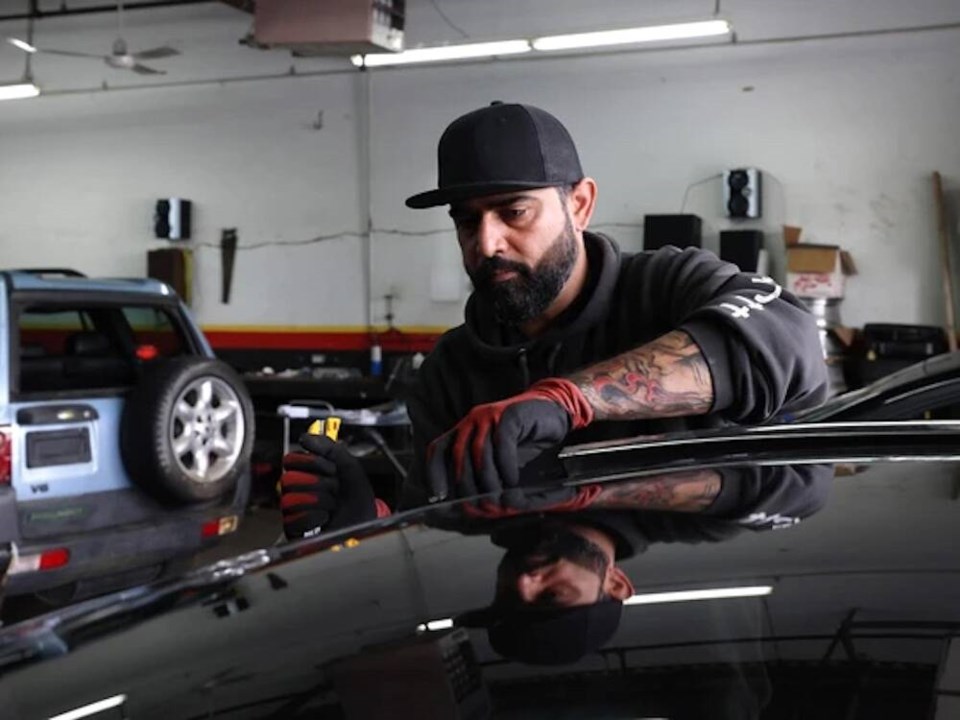Paula Sawrenko calls the commuter car she used to drive her “three-windshield car.”
Before COVID-19 closed her office, she commuted from Port Moody to Abbotsford on Highway 1. Her car was regularly hit by flying rocks, requiring three windshield replacements over several years.
She has a new car now, but was reminded of the three-windshield car on Saturday, when a rock came flying “out of nowhere” and struck her windshield, leaving a chip.
“It scared me,” she said. “It came right at my face. Thankfully it was small.”
Sawrenko was one of dozens of drivers who posted concerns about flying rocks on Reddit earlier this month after a woman was killed by a large rock while driving on highway 1 in Burnaby. The posts contained stories of close calls and cracked windshields, as well as frustration with the volume of truck traffic on commuter routes.
Data collected by ICBC shows a growing number of glass repair and replacement claims across the province, but the Crown corporation wouldn’t speculate on the reasons behind the increase.
ICBC paid to repair or replace more than 216,000 windshields in 2022, up from about 200,000 in 2021.
Windshield replacements cost almost $164 million in 2022, while repairs totalled $4.8 million.
ICBC spokesperson Lindsay Wilkins said the cost for windshield claims has increased every year since 2018, with a big jump in 2022 when inflation, labour and supply chain issues made parts more expensive.
That year there was also an 11 per cent increase in glass replacement claims as drivers returned to the roads after the pandemic.
But Wilkins said ICBC’s free windshield chip repair program introduced in 2017 has saved many drivers from paying the deductible for a full replacement, while prolonging the life of their windshield.
She didn’t respond to questions about whether the rising number of windshield claims could be connected to loads that aren’t properly secured, an issue that came up repeatedly in online discussions.
Sawrenko said she’s followed trucks with broken tarps that do little to prevent gravel from flying out.
“You’d think with technology we might have a better solution than a flimsy little tarp that flaps in the wind and is open at the sides,” she said.
Cpl. Melissa Jongema, spokesperson for the B.C. Highway Patrol, said police continue to investigate the death of the woman on Highway 1, but there is no indication the rock came from an unsecured load.
She said it was too soon to comment on how the rock might have ended up in the woman’s car, but noted there are several possibilities, including that it was propelled from the roadside by a tire or that it was sitting in the wheel or axle area of a truck before flying loose.
She said the Transportation Ministry regularly patrols for unsecured loads and for issues with commercial vehicles.
But the ministry said it doesn’t track the number of tickets or warnings issued to commercial vehicles for failing to secure or tarp loads, and it wasn’t aware of any evidence the problem is growing.
“Officers at provincial inspection stations and on mobile patrols educate drivers and enforce compliance with provincial load securement safety regulations, as well as national standards, as part of their monitoring and enforcement,” said a ministry statement.
Provincial law states cargo must be secured so that it can’t “leak, spill, blow off, fall from, fall through or otherwise be dislodged” from a vehicle.
Sid Joshi, owner of Maple Auto Glass in Surrey, said his work has steadily increased over the last two decades, but he attributed it to the increase in traffic. Because of his location, he repairs many windshields that have been damaged on Highway 17, a busy truck route.
While he advises drivers to avoid tailgating to prevent rock chips, he admitted there’s “not much you can do” to avoid them.
“You can’t really stay off the highways, and you can’t swerve to avoid the rocks,” he said. “Keeping your distance, leaving some space between other vehicles, could potentially help you.”
Joshi said the biggest change he’s noticed in recent years is in the cost to replace a windshield. Over the last five years, many vehicles have started to include safety cameras and sensors attached to the windshield.
A replacement used to take him an average of 2 1/2 hours, but it now takes an additional hour to reattach and calibrate the sensors. In order to do the calibration, he had to purchase equipment worth almost $30,000. The calibration adds about $200 to $400 to a job, bumping the cost of a replacement for a high-end luxury vehicle to about $2,500. In comparison, a replacement for an older truck with no bells and whistles might cost $700.
Ruchika Maggon of Fixman Auto Glass Repair in Surrey said drivers often don’t deal with rock chips until it’s too late, necessitating a full replacement.
“They don’t come right away and it turns into a crack,” she said.
Maggon said she hasn’t seen an unusual increase in windshield repairs over the last several months, but winter is always a busier season because there’s more rocks on roads. People might get a chip from a truck on the highway, but it won’t start to crack until the weather warms up and the glass expands, she said.



